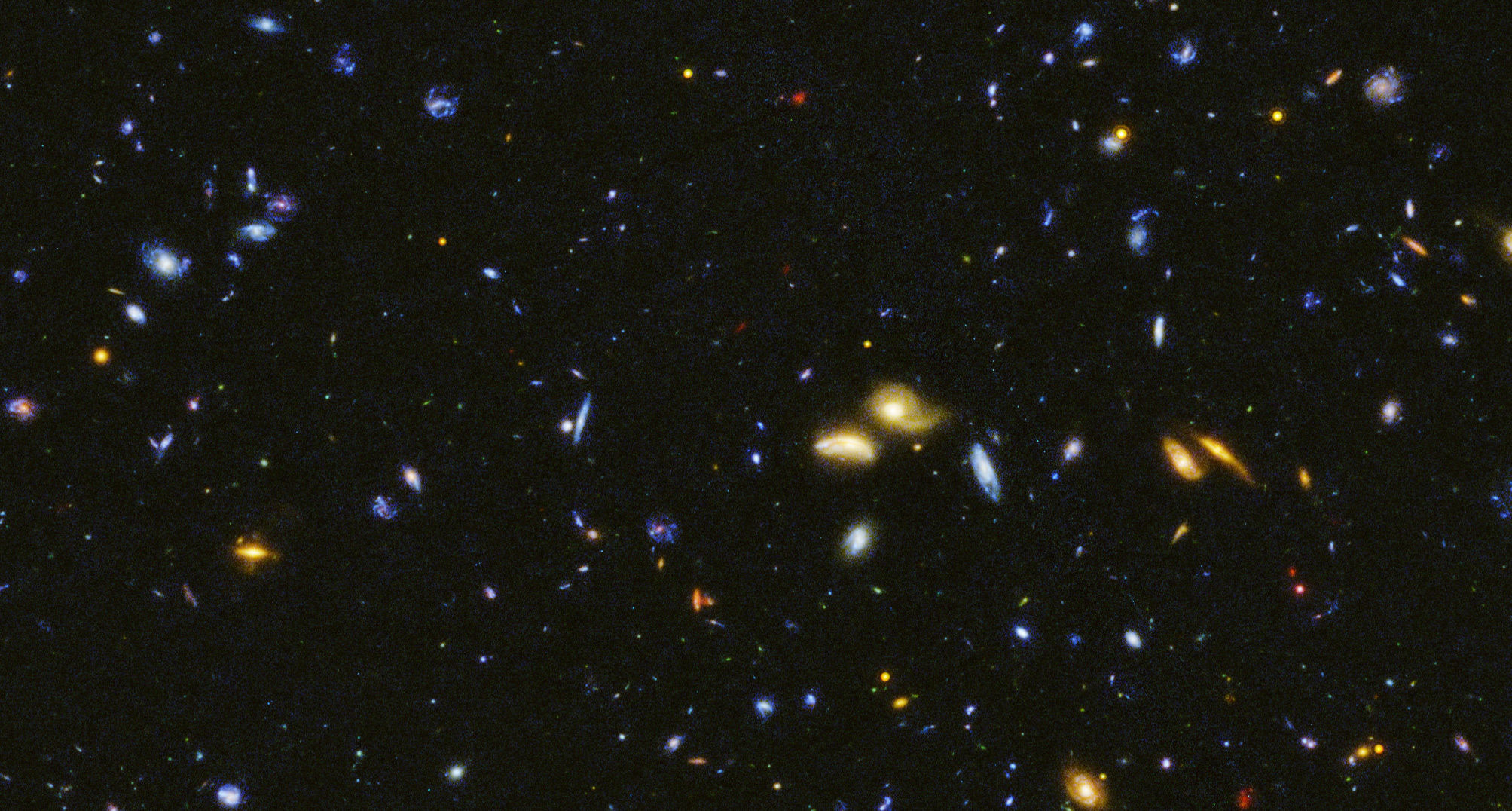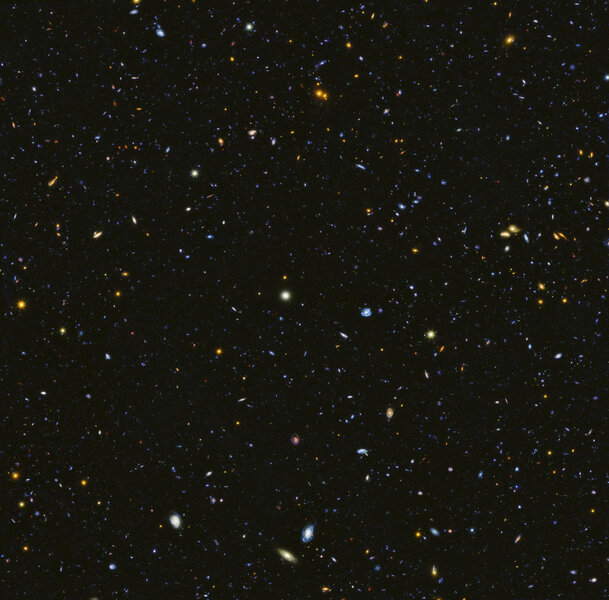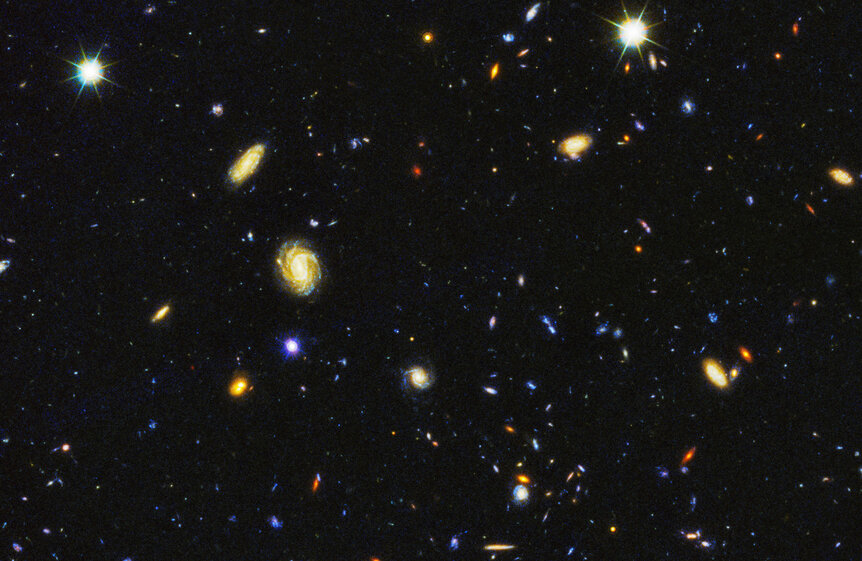Create a free profile to get unlimited access to exclusive videos, sweepstakes, and more!
Hubble goes deep and finds thousands of galaxies assembling when the Universe was young

Astronomers just released two astonishing images from Hubble: super-deep ultraviolet and infrared images of the sky that show thousands of galaxies.
And by thousands, I mean like 15,000 individual galaxies between them.
That’s a lot of galaxies*. These important images will be pored over by scientists to try to figure out weird stuff about the Universe.
The images were taken for a project called the Hubble Deep UV Legacy Survey, or HDUV, and together they total over 25 total hours of exposure time! That’s a lot for any telescope, but for Hubble, that’s deep. They cover about 100 square arcminutes of sky, about the apparent size of a large grain of sand on the tip of your finger held at arm’s length. Yet inside that tiny area are the keys to the cosmos.
The two fields were taken near the north and south celestial poles on the sky. Here’s the HDUV north field:
Wow. Mind you, nearly everything you see in there is a galaxy, a collection of billions of stars, huge clouds of gas and dust, and piles of invisible dark matter surrounding them. To be fair, there are quite a few local Milky Way stars in there, too. You can generally tell the difference by looking for diffraction spikes, the little lines coming out of the centers.
Stars are point sources (too small to resolve, or see as anything but a dot), and their light gets bent around the metal vane holding Hubble’s secondary mirror in place. Galaxies are extended objects, bigger than dots, and that tends to suppress the spikes. Some galaxies have bright cores that can make spikes too, so this isn’t a 100% reliable method… but if you poke around you’ll see that galaxies vastly outnumber stars.
The south field looks very similar to the north one:
These images are a little oddly colored. What you see as blue is actually a combination of Hubble images in ultraviolet and visible light. Green is actually near-infrared light, and red is even farther out in the IR. So any galaxy that looks blue is emitting mostly in UV, while ones that look red are glowing in the infrared.
It’s actually more complicated than this, because isn’t everything? The Universe is expanding, and that stretches the wavelengths of the light emitted by the galaxies. A galaxy might blast out UV light, but by the time it gets here billions of years later it’s been stretched out to infrared light. When they study these galaxies, astronomers will have to take that into account for each individual galaxy to understand just what kind of light it’s emitting.
That’s super important. There are several reasons these images were taken. One is that the first star were born a few million years after the Big Bang. These ridiculously massive stars blasted out UV light, which slammed into hydrogen gas between the stars, ripping their electrons off. This event is called reionization, and it played a key role in the early Universe.
The thing is, that gas then becomes opaque to UV light, and blocks a lot of it coming from those galaxies. But we don’t know how much gets blocked. 5%? 90%? We can’t see that light directly yet (it would take a much bigger ‘scope than Hubble to detect it reliably), so we use closer, brighter galaxies as proxies, standing in for earlier ones, and measure their output. But measuring how much UV they put out is still pretty hard. These new images from Hubble will directly sample that light from distant galaxies, hopefully allowing astronomers to get that number. It should take 10-20% of that light escaping to reionize the Universe, and now we’ll be able to find out how close real galaxies get to the prediction (note: These images were just released, and it’ll be a while before they’re fully analyzed).
Another reason these observations were made becomes more clear when you look at the full-resolution images (those above are displayed at about 1/3rd scale). Here’s a piece of the northern field shown at full res:
A lot of the galaxies look relatively normal, many with spiral arms and central bulges. Note that these tend to look yellowish and are bigger; these are closer to us. Because of that, we see them at an age when they’ve had time to form and mature a bit (they also emit light at all wavelengths, which, when added together, looks yellow in these images).
But if you look at the smaller galaxies they appear, well, rougher. Clumpy, ill-shaped, more like galaxy pieces than whole galaxies. Those are farther away, and haven’t had time to mature yet. In these observations we see galaxies spanning a range of age of the Universe when galaxies started to settle down, form nice disks and central bulges. By analyzing these images astronomers will be able to better understand how that worked, which at the moment isn’t well understood.
Also, the star formation rate in the Universe — literally, the rate at which stars are born — peaked when the Universe was about 3 billion years old. These images show galaxies older and younger than that, allowing astronomers to see how this much higher stellar fecundity affected the galaxies. In general, past observations have only seen the brightest galaxies at this time, but these images show much fainter ones. These smaller galaxies are more common, and may have provided the bulk of the star formation back then. Now, for the first time, we can see those galaxies directly, and can figure out how much they contributed to the stellar population.
The original Deep Field images were taken in 1995. Since then, they’ve been repeated in other parts of the sky, been extended, gone deeper, and had more wavelengths (like IR and UV) added. These new HDUV observations were made to extend the CANDELS-Deep (Cosmic Assembly Near-infrared Deep Extragalactic Legacy Survey) fields, which in turn were observations of the central regions of the GOODS (Great Observatories Origins Deep Survey). Clearly, a huge amount of effort has been made by dozens, by hundreds of astronomers to plan, design, execute, and analyze these tremendous surveys of the deep Universe by Hubble and other observatories.
These deep fields weren’t part of the original mission for Hubble, but once the observatory had been in space for over a dozen years it became easier to free up time to simply stare at one part of the sky to see what it could see. It’s now been over 28 years since it roared into space on board the Space Shuttle Orbiter Discovery, and it’s still able to create data that will have a profound impact on our understanding of the Universe, especially when it was a fraction of the age it is now.
Think on that. We can peer into the black and tease out of it photons that have been traveling through the cosmos for billions of years, passing through galaxies, gas clouds, the thin material in intergalactic space… then finally our own galaxy, our solar system, to find their journey’s end at the school-bus-sized observatory we humans built and then modified specifically to catch them.
These images have tremendous scientific merit, but I wonder if, in the long run, their importance will be more about how they shape our philosophies. And just knowing that such things are able to be done, and that we do them, makes me proud to be human.
*In the paper, the astronomers note they find 18,000 sources at a high degree of certainty. Not all of them are galaxies, though. They don’t state it explicitly in the paper, but the NASA press release says that there are 15,000 galaxies in the images.




























